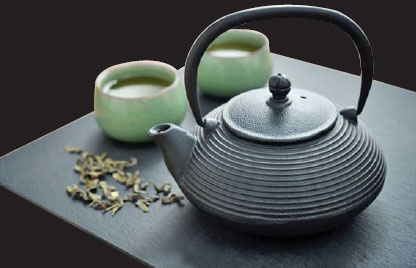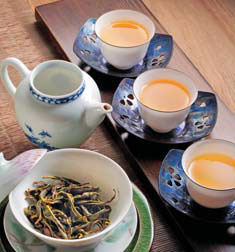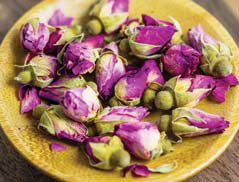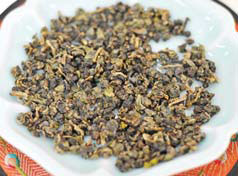For all the tea in China
Updated: 2016-07-15 08:08
By Pauline D Loh(China Daily Europe)
|
|||||||||
Editor's note: To understand China, sit down to eat. Food is the indestructible bond that holds the whole social fabric together and it is also one of the last strong visages of community and culture.
Tea changed the world for China. These fermented leaves of the Camellia sinensis were an important part of the chain of events that toppled the last imperial dynasty of the Middle Kingdom, forced open its lacquered gates to the Western world and started it on the path to revolution.
It was for the love of tea that Western traders decided to introduce opium to China to correct what they perceived as an imbalance in trade. Too much silver was being paid for the crates of Chinese tea.


It was for the love of the brew, too, that Western plant hunters surreptitiously stole cuttings of Camellia sinensis and transplanted them from Moganshan in Jiangsu province to Ceylon, now known as Sri Lanka, and started plantations for the vast markets of the rest of the British Empire.
Long before these cavalier adventurers arrived, there was already a historic exchange along the Silk Road, so tea was not an unfamiliar commodity in the West. Less well-known than the Silk Road but no less important was the Ancient Tea-Horse Caravan Route - chama gudao - between Tibet and the southwestern province of Yunnan.
Yunnan is home to pu'er, the name of both town and the famous fermented black tea. This is one of the oldest origins of tea, and the ancient tea trees are still being harvested to this day.
Tibetans love their tea, cooking it with butter, and their traditional currency for exchange were the sturdy native ponies that were ideal to work the hilly terrains of Yunnan. Remnants and relics of this ponies-for-tea barter can still be seen all along the old trade corridor, including the ancient towns of Lijiang, Shuhe and Dali.
No one knows for sure when the Chinese started drinking tea, or what serendipity prompted them to throw the first tea leaves into hot water. All we know is that tea-drinking was part of culinary culture for as long as folk memory exists. Tea is for both the elite and the earthy.
The farmer in the field quenches his thirst with the tea he probably harvested and dried. The worker in the city may have to buy his tea and then steep the leaves in a large recycled screw-top jar that keeps the drink from spilling and serves as a convenient glass.
On the other end of the scale, there are tea leaves that sell for thousands of dollars per gram and are treated more like investments.
The drinking of tea can also be an art, with as many rituals and rites involved as there are special ceramics and pottery specially created for the brew.
Tea in China is almost never drunk with sugar or milk, but is steeped only in hot water and enjoyed for its natural fragrance and flavor. But there is still great scholarship in what tea to drink in which season, at what age, on which occasion, and even at what temperature the water should be for which types of tea.
There are roughly three major categories of tea - green, semi-fermented and aged, and fully fermented. Each type demands a different treatment.
My first memory of tea was the ink black pot of pu'er that sat on the dim sum restaurant table surrounded by shrimp dumplings, bean curd rolls and char siew pork buns. The Cantonese like their pu'er black and thick, believing rightly that the tannin in the tea will aid digestion and cut some of the greasiness of their beloved snacks.
Sometimes, a few dried chrysanthemum petals went into the pot to add fragrance and make the bitter brew more palatable.
My grandfather, originally from Fujian province, a major producer of quality teas in China, broke the rules whenever he had tea for supper. He brewed top-quality cliff-top tea from Fujian and drank it with condensed milk.
It was an aromatic brew, and on reflection I can now understand why war started over tea.
Fujian is famous for its cliff teas, where the tea bushes cling perilously to precipices and are honored with names such as Big Red Robe and Little Red Robe - rare teas that have limited harvests. When former US president Richard Nixon visited China, he was given a kilogram of Big Red Robe, half the production quota that year.
The region produces a semi-fermented tea that still retains some visages of green. Western drinkers may recognize tieguanyin, or Iron Buddha tea.
Around the Jiangsu and Zhejiang lakes and Yangtze River Delta, green tea is cultivated, and every year before the spring rains, longjing or dragon well tea is harvested. This is the rare first harvest, hand-fried in huge iron pans and fetching very high prices.
Later on, just after Tomb-Sweeping Festival, the last green tea of the year will be plucked.
Chinese tea drinkers also like tea that has been infused with flowers. Old Beijingers love their huacha or flower tea, oolong tea leaves infused with white jasmine. Both tea and jasmine are not native to the dry arid climate of the Chinese capital, but huacha has been the tea of choice here for too long to remember.
To the south in Shanghai, they like tea that has been scented with tiny osmanthus flowers.
Tea is considered an indispensable beverage for the average Chinese and it is a drink enjoyed alone, or with friends, drunk from a well-used earthen mug or elegant, paper-thin porcelain. It is liquid gold that is both affordable and accessible.
paulined@chinadaily.com.cn
A spectrum of tea varieties:
Green tea

This is tea in its most original form, unfermented but simply dried or lightly fried so that it retains its green color. The brew is equally lightly colored, and flavored. Well-known varieties include longjjng from West Lake, biluochun from around Taihu Lake, and maofeng from Huangshan Mountain.
Red tea
A fermented tea that has a reddish tinge to both leaves and brew. Most famous representatives are English breakfast, qihong from Anhui province and dianhong from Yunnan province.
Flower tea

Flower-infused teas are popular not only in Beijing, but also in the southern provinces. Jasmine and osmanthus are most often used, but citron, roses and lilies are also popular choices. The best jasmine teas are from Fujian province, which produces both the tea and the flower.
Oolong tea

How do you tell if it is a oolong tea? You look at its color. The best semi-fermented tea always has a green center and a fringe of brown-red on each leaf. Some of the best oolong is produced in Fujian and Taiwan, although a broader area of production now spreads right to the Sichuan-Yunnan highlands in response to worldwide demand.
Black tea
A fully fermented tea, and probably the oldest. There are countless regional varieties, but the most famous has to be Yunnan's Pu'er. Its most common form is in a tightly compressed cake that loosens up with age. Pu'er should always be freshly brewed, rested then drunk immediately and not be left in the pot for too long.
(China Daily European Weekly 07/15/2016 page20)
Today's Top News
Live: Truck attack kills over 80 in Nice
Li slams attack in France, expresses condolence
May stuns political world by appointing Boris Johnson
Li calls Sino-Mongolia ties 'best ever'
Russian, Chinese officials discuss space cooperation
25 killed, 50 injured as trains collide in Italy
EU called on to fulfill WTO promises
Ruling inherently biased and unjust 'piece of paper'
Hot Topics
Lunar probe , China growth forecasts, Emission rules get tougher, China seen through 'colored lens', International board,
Editor's Picks

|

|

|

|

|

|







